Sustainable Learning recognises a complex ecology, with many layers of influence affecting teaching and learning. At the heart of teaching and learning are the students who are building capabilities for learning and for life, thus we use a capabilities approach, and rely on the ATRiUM capabilities model. Sustainable Learning has a basic set of principles for teachers, the Deliberate Actions of Responsive Teachers, and an eight step cycle of Responsive Teaching which guides teachers in providing Layers of Responsive Teaching, within which they use evidence-based teaching approaches, and expertly designed learning opportunities for their students.
A complex ecology of influences on teaching and learning
Responsive Teaching for Sustainable Learning – RT4SL – is a very complex beast! The graphic representation tries to encapsulate the key components, which are explored in the 2024 book, Responsive Teaching for Sustainable Learning.
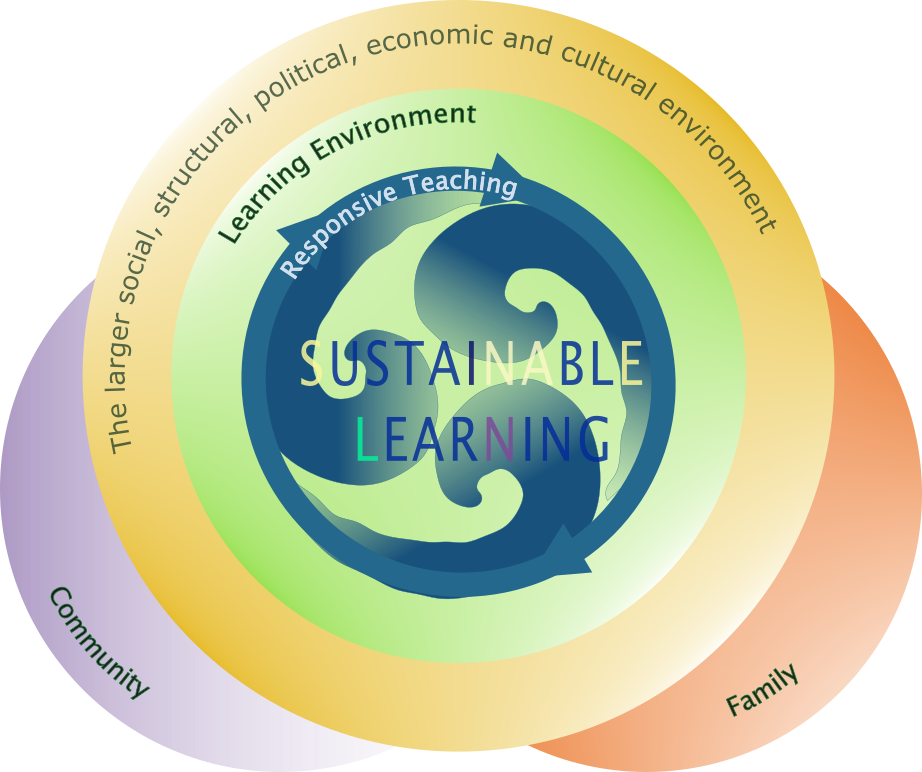
The concentric circles show the layers of influence on teaching and learning, with the outer layer representing the larger social, structural, political, economic and cultural environment. The key aspects of these influences are found in international conventions, national legislation, education system policies, the curriculum, teacher registration and cultural and community contexts. Within this larger environment is the learning environment within which teach and learning happen. Key dimensions of the learning environment include, the spaces for teaching and learning, school culture organisation and ambience, and the practical arrangement of furniture and resources. Within this complex context are the teachers and students engaged in relationships and enacting their roles as teachers and learners.
It is clear that teaching and learning happen within a complex ecological system that is affected by multiple issues and conditions and that is before we look at what each community, family and student, and their teachers bring with them to this situation.
A Capabilities Approach – ATRiUM
Each student has developing capabilities that are needed when learning and throughout life. Capabilities or competences are integral to curriculum across the world, and different systems have distilled these to suit their own cultural contexts. Sustainable Learning uses five capabilities, known by the acronym ATRiUM, which refers to teaching students to be active learners (A), to use depth and breadth of thinking (T), to effectively relate to others in teaching and learning (R), to use language other symbol systems and information communication technology to engage in learning (iU), and to manage themselves as learners (M). We accept that these capabilities are constantly developing throughout life, and that each of us depends on them with varying emphases. It is our job as teachers to support the integrated development of all of them.
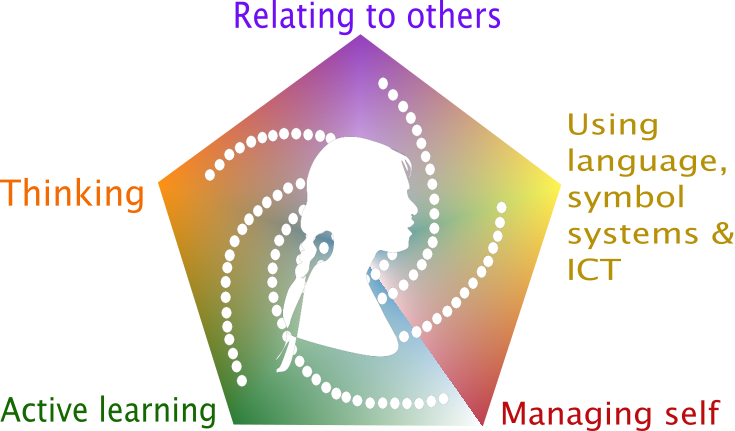
ATRiUM is also a useful framework for thinking about how learners who experience difficulties or barriers in learning may be engaging with their world and how we can actively reduce barriers to learning for them.
Influences within the complex ecology of teaching and learning and ATRiUM Capabilities are used when developing individual Sustainable Learning Profiles, within which teachers can highlight what is supporting learning and what is hindering learning for a particular student, followed by evaluation of the evidence and generation of implications for teaching and learning at this time. More about SLPs can be found in Chapter 8 of Responsive Teaching for Sustainable Learning.
“Upon reflecting over Mika’s struggles to manage his emotions when presented with a change in his routine, I had not considered how actively he was trying to solve his problems. I had not considered that his ‘meltdowns’ were actually his way of trying to communicate and cope with something he found immensely difficult.” – a teacher who was introduced to using Sustainable Learning Profile to consider the learning needs of her students, Responsive Teaching for Sustainable Learning (2024, p.112)
Deliberate Actions of Responsive Teachers – DARTs
The seven DARTS are fundamental to interactive teaching-learning relationships, and creating an atmosphere within which students feel safe to take risks as they learn. These actions are derived from evidence from mediated learning (Skuy, 1997), direct instruction (Liem & Martin, 2013), high impact aspects of teacher expertise (Hattie, 2017) and effective inclusive teaching (Mitchell, 2020) to distill what makes interactions between teachers and learners effective and successful.
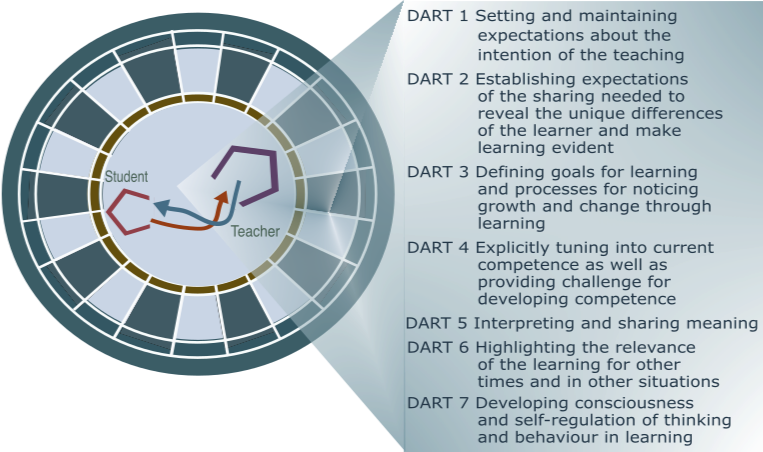
These DARTS provide a framework for teachers to reflect on how they set up the conditions for effective relationships with their students so that learning is optimised.
The Responsive Teaching Framework – RTF
The Responsive Teaching Framework guides teachers in their reflective practice with eight steps. These steps ensure teachers consider the complex ecology of their teaching, their own unique skills,. knowledge and experiences, those of their students, what needs to be taught now and how best to do it, and how to make sure assessment and feedback support teaching and learning., Finally, teachers are required to reflect on their teaching and to evaluate how their teaching supported their students’ learning.

Each of the eight steps has structure within which teachers can consider the important aspects of these issues: For example, the frameworks to be considered in RTF 1 are related to the layers of influence identified in the ecological model, those that are from the social, structural, political, economic and cultural environments and they include international conventions related to inclusive education, national and state laws, education system policies and procedures, curriculum teacher registration requirements, cultural and community contexts, school culture and organisation and learning environments. More detail and guidance for each of these steps is included in the published books Sustainable Learning (2015), Learning Intervention (2018) and Responsive Teaching for Sustainable Learning (2024).
Layers of Responsive Teaching
The model of Layers of Responsive Teaching provides teachers with a way of thinking about how to respond to the needs of all students, by providing appropriately targeted and intensive teaching, through flexible and dynamic teaching. The foundation layer is evidence-based classroom teaching, beginning with Universal Design for Learning (UDL) that provides options for students in the ways they engage in learning. As teachers get to know their students as learners, they are able to curate the opportunities for learning for their class and for individual learners, which is what we call Responsive Differentiation. Flexible groupings are inherent in this base layer of teaching, using large group, small group and individual teaching at times to best respond to the students’ learning needs.
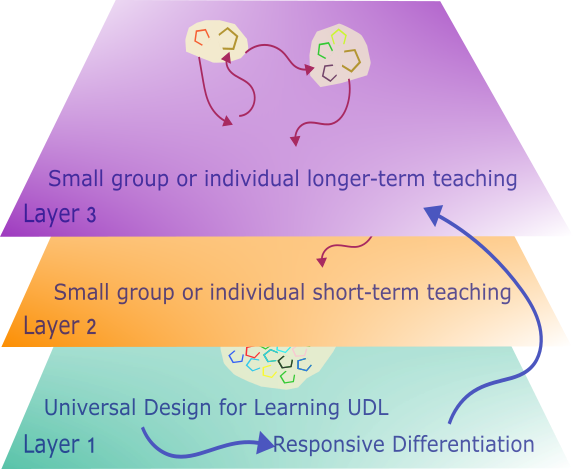
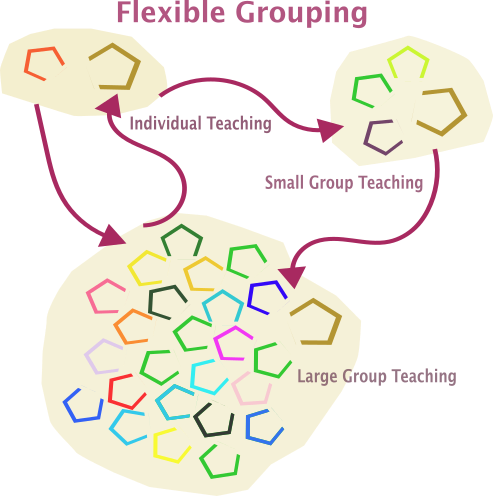
Complementing this base layer of robust, responsive classroom teaching is a second layer of teaching, that is increased intensity of teaching for some students at times, providing short-term intense teaching in small groups or individually. Many educational settings develop and implement short-term interventions that match the role of this layer, supporting students who have missed learning opportunities for whatever reason.
The third layer of responsive teaching is that which is needed by some students to reduce the barriers inherent in their learning due to disabling conditions or circumstances. These longer-term intensive, targeted teaching in small groups of individually can be provided by teachers as part of the class lessons, or by specialist teachers or other professionals, outside the classroom and sometimes in therapy rooms.
All three layers are necessary for an educational setting to be able to provide the range of intensity needed for the diversity of learners, and are organised to respond to the assessed learning needs of students, which change constantly. Therefore this model is essentially flexible and dynamic, and based on evidence of learning.
Evidence within Responsive Teaching
Responsive Teaching relies on evidence to support complex decision making; it is both research-based and evidence based since research is included as part of a broader conceptualisation of evidence. We draw on different types of evidence, including research, to inform practice. To illustrate the need for a range of sources of evidence we use the metaphor of spotlights which illuminate our practice. Four types of evidence are needed for sophisticated evidence-based practice, each of which provides more light on our practice of Responsive Teaching for Sustainable Learning.
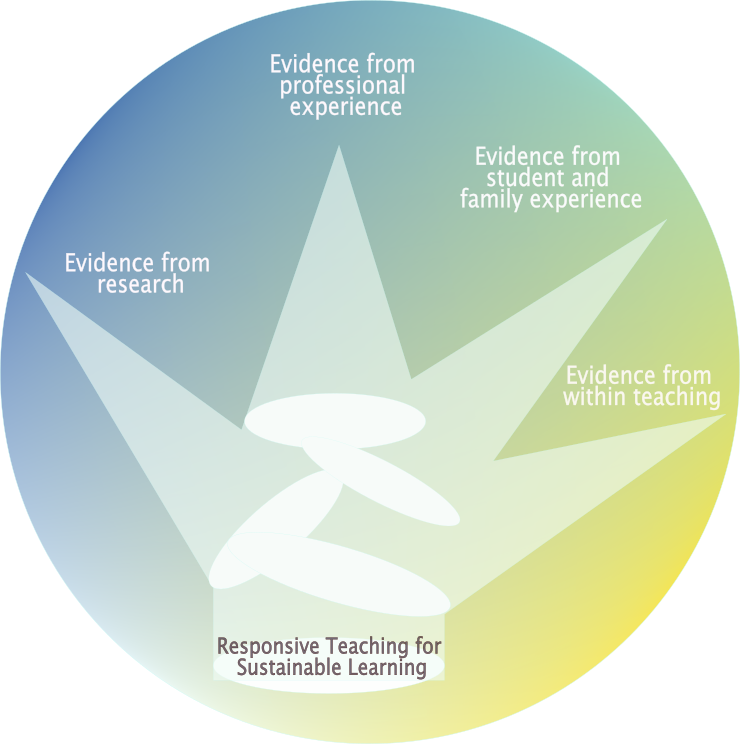
Within Responsive Teaching for Sustainable Learning we consider research evidence about effective teaching and learning with a focus on teaching strategies that work to build capabilities in learning within differentiated learning opportunities.
“It is easy to be overwhelmed by the range of evidence for teaching strategies and influencers who advocate for approaches and strategies. Teachers can access individual research students regarding effective teaching and then assess and make judgement about how relevant the evidence is for their teaching situation. This process is extremely time-consuming and not always feasible. To make research more accessible for teachers several researchers and organisations have constructed reviews, meta-analyses, and database portals that curate research evidence.” Responsive Teaching for Sustainable Learning, 2024, p. 24
In curating the evidence for Responsive Teaching for Sustainable Learning we have drawn on the enormous body of research evidence within major research collations as well as explored individual research studies, and we make sense of it in light of our own research and our professional experience in teaching and school psychology. The evidence directs us to the following teaching approaches and helps us carefully consider the nature of the learning opportunities we provide for our students.
Effective Teaching Approaches & Learning Opportunities
Responsive teachers use a variety of approaches selected to be most effective for the needs of their students as learners, and the nature of what is being taught. Differentiated and culturally responsive approaches are fundamental, and are complemented by collaborative, explicit and cooperative group teaching. They are also supported by formative assessment and targeted feedback.
Teaching needs to be: Differentiated
Culturally Responsive
Explicit
Collaborative
Cooperative Group
and supported by Formative Assessment & Feedback
Learning opportunities should be aligned with the intended learning outcomes, and described with action verbs that can be enacted and identified. Universal Design for Learning Guidelines support differentiation and student choice. Teachers need to carefully consider when student activity should be interactive, constructive, active and passive (ICAP); what tasks and associated materials are needed, the intensity and arrangement of the tasks; the support required, appropriate groupings, place and space, adjustments and resources.